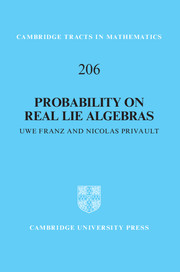Book contents
- Frontmatter
- Dedication
- Contents
- Notation
- Preface
- Introduction
- 1 Boson Fock space
- 2 Real Lie algebras
- 3 Basic probability distributions on Lie algebras
- 4 Noncommutative random variables
- 5 Noncommutative stochastic integration
- 6 Random variables on real Lie algebras
- 7 Weyl calculus on real Lie algebras
- 8 Lévy processes on real Lie algebras
- 9 A guide to the Malliavin calculus
- 10 Noncommutative Girsanov theorem
- 11 Noncommutative integration by parts
- 12 Smoothness of densities on real Lie algebras
- Appendix
- Exercise solutions
- References
- Index
3 - Basic probability distributions on Lie algebras
Published online by Cambridge University Press: 05 February 2016
- Frontmatter
- Dedication
- Contents
- Notation
- Preface
- Introduction
- 1 Boson Fock space
- 2 Real Lie algebras
- 3 Basic probability distributions on Lie algebras
- 4 Noncommutative random variables
- 5 Noncommutative stochastic integration
- 6 Random variables on real Lie algebras
- 7 Weyl calculus on real Lie algebras
- 8 Lévy processes on real Lie algebras
- 9 A guide to the Malliavin calculus
- 10 Noncommutative Girsanov theorem
- 11 Noncommutative integration by parts
- 12 Smoothness of densities on real Lie algebras
- Appendix
- Exercise solutions
- References
- Index
Summary
The theory of probabilities is at bottom nothing but common sense reduced to calculus.
(P.S. de Laplace, in Théorie Analytique des Probabilités.)In this chapter we show how basic examples of continuous and discrete probability distributions can be constructed from real Lie algebras, based on the annihilation and creation operators a−, a+, completed by the number operator a◦ = a+a−. In particular, we study in detail the relationship between the Gaussian and Poisson distributions and the Heisenberg–Weyl and oscillator Lie algebras hw and osc, which generalises the introduction given in Chapter 1. We work on the Fock space over a real separable Hilbert space h, and we also examine a situation where the gamma and continuous binomial distributions appear naturally on sl2(R), in relation with integration by parts with respect to the gamma distribution.
Gaussian distribution on hw
Since the Heisenberg–Weyl Lie algebra hw is based on the creation and annihilation operators a− and a+ introduced on the boson Fock space l2 in Chapter 1, we start with an extension of those operators to an arbitrary complex Hilbert space.
Namely, we consider
a) a complex Hilbert space h equipped with a sesquilinear inner product ⟨·, ·⟩, such that
b) two operators a− and a+, called annihilation and creation operators acting on the elements of h, such that
(i) a− and a+ are dual of each other in the sense that
which will also be written, for the scalar product ⟨·, ·⟩, and
(ii) the operators a− and a+ satisfy the commutation relation
where E commutes with a− and a+,
c) a unit vector e0 ∈ h (fundamental or empty state) such that a−e0 = 0 and ⟨e0, e0⟩ = 1.
We will show that under the conditions
(e.g., when E = σ2Ih where Ih is the identity of h), the operator Q = a− +a+ has a Gaussian law in the sense that it yields the moment generating function
which extends in particular the example of Exercise 1.1 to moments of all orders. Similarly, we could show that P = i(a− −a+) also has a Gaussian law in the state e0, see Exercise 3.1.
Next, we will consider several representations for the aforementioned noncommutative framework.
- Type
- Chapter
- Information
- Probability on Real Lie Algebras , pp. 27 - 46Publisher: Cambridge University PressPrint publication year: 2016



